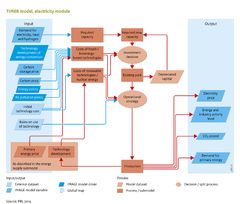Energy conversion/Description: Difference between revisions
Jump to navigation
Jump to search
No edit summary |
No edit summary |
||
| Line 68: | Line 68: | ||
===Fossil-fuel and bio-energy power plants=== | ===Fossil-fuel and bio-energy power plants=== | ||
A total of 20 types of power plants generating electricity using fossil fuels and bioenergy are included. These power plants represent different combinations of conventional technology, such as gasification and combined cycle (CC) technology; combined heat and power (CHP); and carbon capture and storage (CCS;(Hendriks et al., 2004b). The specific capital costs and thermal efficiencies of these types of plants are determined by exogenous assumptions that describe the technological progress of typical components of these plants: | A total of 20 types of power plants generating electricity using fossil fuels and bioenergy are included. These power plants represent different combinations of conventional technology, such as gasification and combined cycle (CC) technology; combined heat and power (CHP); and carbon capture and storage ({{AbbrTemplate|CCS}};([[Hendriks et al., 2004b]]). The specific capital costs and thermal efficiencies of these types of plants are determined by exogenous assumptions that describe the technological progress of typical components of these plants: | ||
*For conventional power plants, the coal-fired plant is defined in terms of overall efficiency and investment cost. The characteristics of all other conventional plants (using oil, natural gas or bioenergy) are described in the investment differences for desulphurisation, fuel handling and efficiency. | *For conventional power plants, the coal-fired plant is defined in terms of overall efficiency and investment cost. The characteristics of all other conventional plants (using oil, natural gas or bioenergy) are described in the investment differences for desulphurisation, fuel handling and efficiency. | ||
*For Combined Cycle (CC) power plants, the characteristics of a natural gas fired plant are set as the standard. Other CC plants (fuelled by oil, bioenergy and coal after gasification) are defined by indicating additional capital costs for gasification, efficiency losses due to gasification, and operation and maintenance (O&M) costs for fuel handling. | *For Combined Cycle (CC) power plants, the characteristics of a natural gas fired plant are set as the standard. Other CC plants (fuelled by oil, bioenergy and coal after gasification) are defined by indicating additional capital costs for gasification, efficiency losses due to gasification, and operation and maintenance (O&M) costs for fuel handling. | ||
| Line 88: | Line 88: | ||
The required spinning reserve of the power system is the capacity that can be used to respond to a rapid increase in demand. This is assumed to be 3.5% of the installed capacity of a conventional power plant. If wind and solar power further penetrate the market, the model assumes an additional, required spinning reserve of 15% of the intermittent capacity (after subtraction of the 3.5% existing capacity). The related costs are allocated to the intermittent source. | The required spinning reserve of the power system is the capacity that can be used to respond to a rapid increase in demand. This is assumed to be 3.5% of the installed capacity of a conventional power plant. If wind and solar power further penetrate the market, the model assumes an additional, required spinning reserve of 15% of the intermittent capacity (after subtraction of the 3.5% existing capacity). The related costs are allocated to the intermittent source. | ||
==Nuclear power== | ===Nuclear power=== | ||
For nuclear power, the costs also consists of capital, O&M and nuclear fuel costs. Similar to the renewable energy options, technology improvement nuclear power is described via a learning curve (so costs decrease with cumulative installed capacity). At the same time, fuel costs increase as a function of depletion. Fuel costs are determined on the basis of the estimated extraction costs of uranium and thorium resources, as is described in the component [[Energy supply]]. A small trade model for these fission fuels is included. | For nuclear power, the costs also consists of capital, O&M and nuclear fuel costs. Similar to the renewable energy options, technology improvement nuclear power is described via a learning curve (so costs decrease with cumulative installed capacity). At the same time, fuel costs increase as a function of depletion. Fuel costs are determined on the basis of the estimated extraction costs of uranium and thorium resources, as is described in the component [[Energy supply]]. A small trade model for these fission fuels is included. | ||
Revision as of 18:38, 8 May 2014
Parts of Energy conversion/Description
| Component is implemented in: |
|
| Related IMAGE components |
| Projects/Applications |
| Models/Databases |
| Key publications |
| References |
